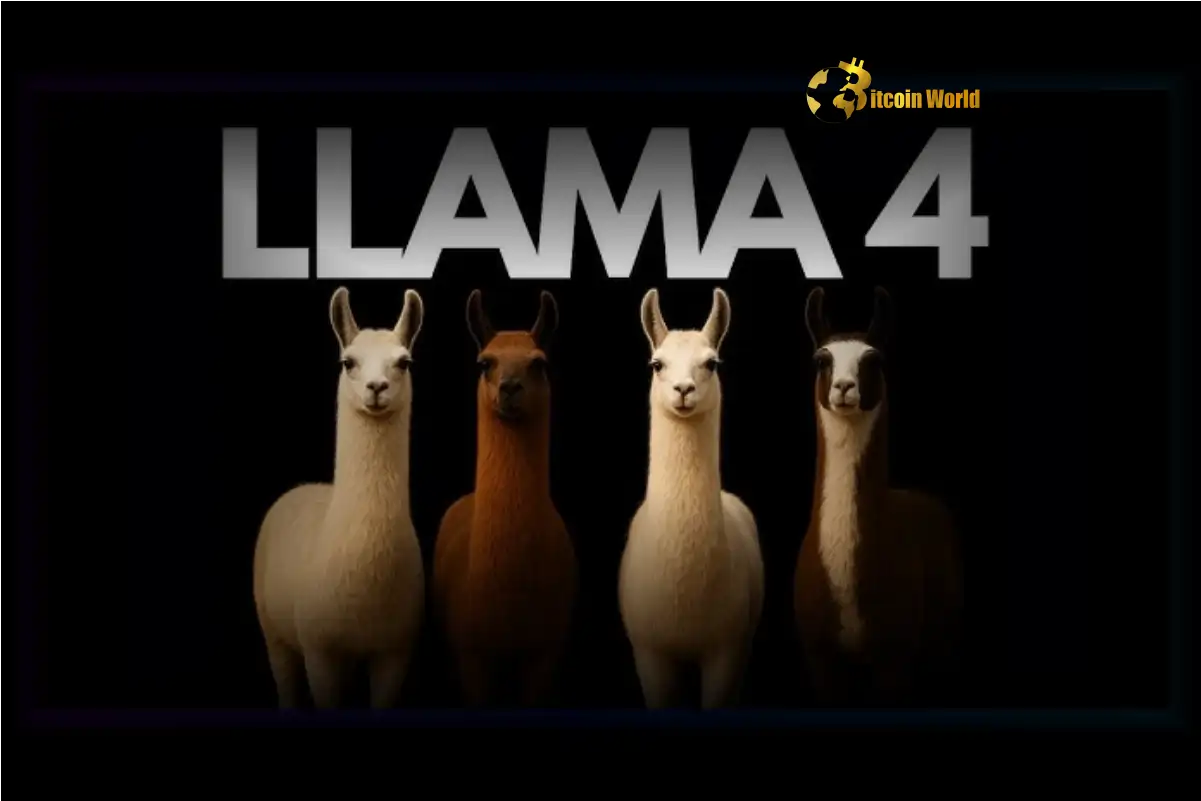Revolutionary Llama 4: Meta Unleashes Flagship Open Source AI Models
0
0

In a surprising Saturday reveal, tech giant Meta has dropped a bombshell in the AI world: Llama 4, a brand-new suite of flagship Meta AI models. This latest iteration in the Llama family isn’t just an upgrade; it’s a leap, featuring four distinct models – Scout, Maverick, and the behemoth of them all, Behemoth – each trained on a massive dataset of text, images, and video. What does this mean for the crypto and tech-savvy audience? It signals a powerful shift towards more accessible and capable Open Source AI, potentially impacting everything from decentralized applications to AI-driven crypto trading tools.
Unpacking the Power of Llama 4: A New Era of Meta AI Models
The buzz around Llama 4 isn’t just hype. Meta claims these models boast a “broad visual understanding” thanks to their diverse training data. Industry whispers suggest that the impressive performance of open models from Chinese AI lab DeepSeek – models rivalling and even surpassing Meta’s previous Llama iterations – lit a fire under Meta’s development team. Fueled by competition, Meta reportedly launched intensive efforts to understand how DeepSeek managed to optimize the cost and deployment of their models like R1 and V3. The result? A new generation of Meta AI models designed for both power and efficiency.
Here’s a breakdown of what makes Llama 4 stand out:
- Open Access for Innovation: Scout and Maverick are readily available on Llama.com and through platforms like Hugging Face. This open access is crucial for developers in the crypto space and beyond, allowing for experimentation and integration into new and existing projects.
- Enhanced Meta AI Assistant: Meta’s AI assistant, Meta AI, already integrated across platforms like WhatsApp, Messenger, and Instagram, has been upgraded to leverage the power of Llama 4 in 40 countries. While multimodal features are currently US-English exclusive, the global rollout indicates Meta’s commitment to widespread AI integration.
- Mixture of Experts (MoE) Architecture: Llama 4 marks Meta’s first foray into MoE architecture. This innovative approach divides complex tasks into sub-tasks, handled by smaller, specialized “expert” models. This leads to computational efficiency in both training and query processing, making these powerful models more accessible.
Consider Maverick, for instance. It packs a staggering 400 billion total parameters, yet only utilizes 17 billion active parameters across 128 experts. Scout, while smaller, still boasts 17 billion active parameters and 109 billion total parameters. These numbers translate to significant processing power without exorbitant resource demands.
Llama 4 vs. the Giants: How Meta’s Open Source AI Stacks Up
Meta isn’t shy about pitting Llama 4 against industry titans. According to their internal tests, Maverick, designed for “general assistant and chat” applications, outperforms models like OpenAI’s GPT-4o and Google’s Gemini 2.0 in specific areas like coding, reasoning, multilingual capabilities, long-context understanding, and image benchmarks. However, it’s important to note that it doesn’t quite reach the heights of Google’s Gemini 2.5 Pro, Anthropic’s Claude 3.7 Sonnet, or OpenAI’s GPT-4.5.
Scout, on the other hand, carves out its niche with exceptional document summarization and large codebase reasoning abilities. Its standout feature? A massive 10 million token context window. To put that in perspective, Scout can ingest and process images and documents containing millions of words. This capability is game-changing for industries dealing with vast amounts of data, including financial analysis in the crypto market.
Here’s a quick comparison table:
| Model | Active Parameters | Total Parameters | Strengths | Hardware Needs |
|---|---|---|---|---|
| Scout | 17 Billion | 109 Billion | Document Summarization, Code Reasoning, 10M Token Context | Single Nvidia H100 GPU |
| Maverick | 17 Billion (out of 400B total) | 400 Billion | General Assistant, Chat, Coding, Reasoning | Nvidia H100 DGX System |
| Behemoth | 288 Billion | ~2 Trillion | STEM Skills, Math Problem Solving | Beefier Hardware (Unreleased) |
Generative AI and the Question of Bias: Llama 4’s Approach
Generative AI models are increasingly scrutinized for biases, and Meta claims to have addressed this head-on with Llama 4. Interestingly, Meta states they’ve tuned these models to be more willing to engage with “contentious” questions. According to a Meta spokesperson, Llama 4 is designed to provide “helpful, factual responses without judgment,” even on debated political and social topics. This move towards more balanced and less biased AI Chatbots is crucial, especially as concerns about AI censorship and political “wokeness” rise.
This adjustment comes amidst accusations from some political figures that AI chatbots are overly biased. The challenge of bias in AI is indeed complex, as even Elon Musk’s xAI has faced difficulties in creating a chatbot free from political leanings. Meta’s efforts to create more responsive and balanced AI Chatbots are a significant step in navigating this intricate landscape.
The EU Hurdle and Licensing: Navigating the Open Source AI Landscape
However, the path to Open Source AI isn’t without its complexities. Developers in the EU face a significant hurdle: the Llama 4 license prohibits use or distribution for users and companies “domiciled” or with a “principal place of business” in the EU. This restriction likely stems from the EU’s stringent AI and data privacy regulations, which Meta has previously criticized as overly burdensome. Furthermore, similar to previous Llama releases, companies with over 700 million monthly active users need to request a special license from Meta, which Meta can approve or deny at its discretion.
Conclusion: Llama 4 – A Bold Step in the Generative AI Revolution
Llama 4 represents a significant stride in the evolution of Generative AI and Open Source AI. With its diverse models, MoE architecture, and focus on balanced responses, Meta is positioning itself as a key player in democratizing access to powerful AI. While licensing restrictions and the ongoing challenge of AI bias remain factors to consider, the release of Llama 4 undoubtedly marks “the beginning of a new era for the Llama ecosystem,” as Meta aptly stated. For the crypto world and beyond, this development opens exciting new possibilities for innovation and application. The race for AI dominance is heating up, and Meta’s Llama 4 is a powerful contender.
To learn more about the latest Generative AI trends, explore our article on key developments shaping AI Models future features.
0
0
 Manage all your crypto, NFT and DeFi from one place
Manage all your crypto, NFT and DeFi from one placeSecurely connect the portfolio you’re using to start.








